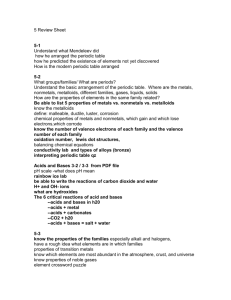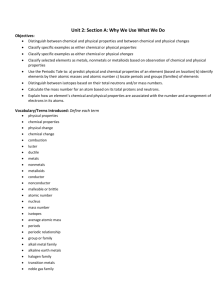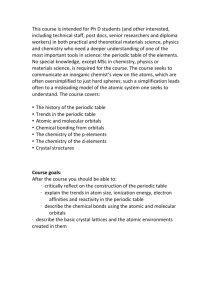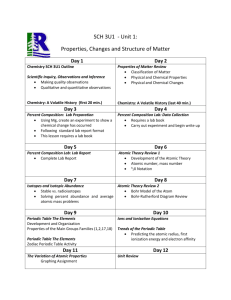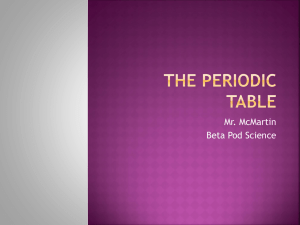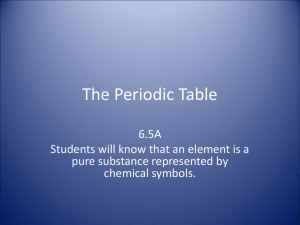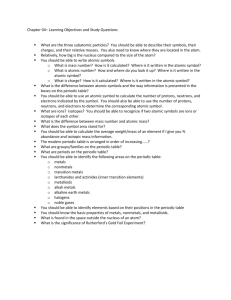Chapter 5 PowerPoint _End_
advertisement
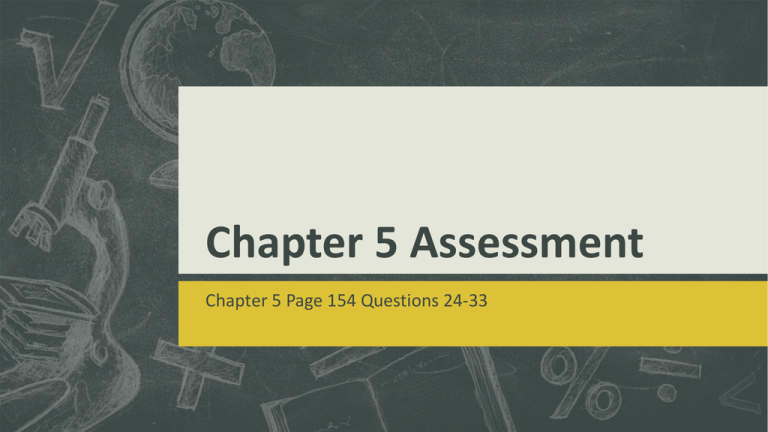
Chapter 5 Assessment Chapter 5 Page 154 Questions 24-33 Question 1: If you know that an element is a solid at room temperature, do you have enough data to classify the element as a metal, metalloid, or nonmetal? If you know that the element is a gas at room temperature, do you have enough data? Explain your answers. Question 1: Answer There is not enough data for the solid because solids at room temperature can be metals, nonmetals, or metalloids. There is enough data for the gas because there are no gaseous metals or metalloids at room temperature. Question 2: An element on the periodic table has two naturally occurring isotopes. One isotope has an atomic mass of about 10 amu. The other isotope has an atomic mass of about 11 amu. What is the name of this element? Question 2: Answer Boron, with an atomic mass of 10.81. Question 3: How many valence electrons would an element with atomic number 113 have? Question 3: Answer Three. Question 4: Why are samples of the alkali metal cesium usually stored in argon gas? Question 4: Answer Cesium is an extremely reactive metal; argon is an extremely unreactive nonmetals. Question 5: Why are halogens found in nature only in compounds? Question 5: Answer Halogens are always found in nature in compounds because halogens are highly reactive nonmetals. Question 6: Which element on the periodic table has chemical properties that are most similar to those of carbon? Question 6: Answer Silicon. Question 7: If you were trying to make a compound of the noble gas xenon, would you use nitrogen or fluorine? Explain your choice. Question 7: Answer You would choose fluorine because it is much more likely to react than nitrogen is. Properties of Elements X, Y, and Z Use the table to answer Questions 31-33. Element •X •Y •Z Melting Point Boiling Point Valence Electrons • 97.80°C • -259.34°C • -101.5°C • 883°C • -252.87°C • -34.04°C •1 •1 •7 Question 8: In general, where would you find Elements X, y, and Z on the periodic table? Question 8: Answer Elements X and Y are in Group 1 (1A) and Element Z is in Group 17 (7A). Question 9: Describe the state of each element at room temperature based on its melting and boiling points. Question 9: Answer Elements Y and Z are gases; element X is a solid. Question 10: Use your answers to Questions 31 and 32 to identify element Y. Explain your reasoning. Question 10: Answer Element Y is hydrogen, because hydrogen is the only gas in Group 1 Chapter 5 Assessment Chapter 5 Page 154 Questions 34-40 Question 11: What might happen to a heated beaker made from glass that does not contain boron if the beaker were placed in a pan of ice water? Question 11: Answer The beaker might shatter. Question 12: Based on the content of most fertilizers, name two elements other than carbon that are found in compounds in plants. Question 12: Answer Nitrogen and Phosphorus. Question 13: Explain how the amount of a trace element an organism is exposed to affects the element’s ability to help or harm an organism. Use the example of selenium. (Hint: Refer to the discussion on page 149.) Question 13: Answer An element that is helpful in small quantities may be harmful when present in larger quantities. For example, trace amounts of selenium help maintain the immune system, but larger amounts can cause nerve damage. Question 14: Sometimes old books fall apart when they are stored in air. Use what you know about the reactivity of elements to propose a way that old books could be kept from falling apart. Question 14: Answer The books would not fall apart if stored in a noble-gas atmosphere. Question 15: Explain how a calendar is similar to a periodic table and how is it different? Question 15: Answer There is a repeating pattern of days and months on a calendar. However, Tuesdays do not necessarily have a different set of properties from Thursdays and there are no trends among Tuesdays equivalent to the trends in atomic mass or reactivity within a group in the periodic table. Question 16: When corn plants have yellow leaves, it is a sign that the plants lack an essential element. Which element must be added to the soil to produce leaves with a healthy green color? Question 16: Answer Magnesium is required to produce chlorophyll, the green pigment in plants. Question 17: You write for a newsletter that has a feature called Element of the Month. It is your turn to write the feature. Pick an element that you think is worthy of attention. Write a brief essay and suggest a photo to be used with your feature. Question 17: Answer The essays should contain accurate information and make a reasonable argument for the value of the element.


